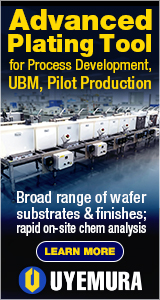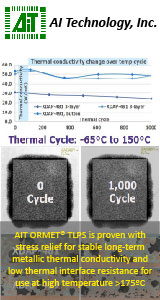|

|
|
| Ask the Experts | |||||||
|
|||||||
|
August 20, 2007 - Updated August 19, 2007 - Originally Posted Good epoxy or cement for bonding BGA packages to PCBWhat would be a good epoxy or cement for bonding the corners of BGA packages to a PCB to prevent thermal flexing of the PCB from cracking the sphere bond between the package and board traces? I have seen the adhesives used on laptop mainboards and need a similar adhesive for our rework process. Rob |
|||||||
| Expert Panel Responses | |||||||
|
You will no doubt here back from the material suppliers who will have recommendations on specific products. From the perspective of a supplier of dispensing equipment, I'm somewhat neutral. You should understand that corner bonding (and the related process of edge bonding) is really not designed to relieve stress from thermal flexing, but more to relieve stress from mechanical shock. In any case, you have a few options. First, as you mentioned, you can go with a corner bonding process or and edge bonding process. You will get some improvement in stress relief, particularly in shear. The terminology is mixed, but I believe that most people refer to the process of dispensing the adhesive prior to component placement as corner bonding. Placement of the adhesive on the edge of the package after reflow is called edge bonding. Another alternative is to do a capillary underfill. Many suppliers have underfill materials specifically designed for BGA underfill and they are typically less expensive that traditional underfill materials. Re-workable BGA underfill materials are also available. Doing a complete underfill may be more than what you are prepared to do, but it will give superior reliability for bending failures. Having said this, most of the adhesive applications you see in BGA on PC boards are to protect the BGA from flex during installation and removal of cards. If you are in a re-work / repair process, the corner bond material can be applied prior to component placement and cured during reflow. If you want to test the board prior to applying the adhesive, the edge bonding process may work better since it allows you apply the adhesive after the repair has been completed. I'd recommend talking to Emerson & Cuming, Epotek, Henkle, Lord, Namics, Shin-Etsu, and Zymet (listed in alphabetical order to avoid showing favorites).
Director of Application Engineering Asymtek Mr. Lewis worked for The Aerospace Corporation for 6 years before joining Asymtek in 1993. He holds multiple patents in dispensing technology for electronics assembly and packaging. He has a Master's Degree in Mechanical Engineering from University of Missouri-Rolla.
NOTE: Mr. Lewis is no longer working at Asymtek. Capillary flow underfills are the best solution for CSP and BGA support in handheld products like cell phones, PDAs and portable music players that have a high likelihood of being dropped. But, for other mobile products like laptops and gaming consoles that may only experience occasional vibration or dropping issues during shipping or bending during card assembly, using a Cornerbond underfill system for these applications is the most cost-effective and time-sensitive solution. With this technology, lines of underfill material are dispensed at the four corners of the CSP or BGA pad site prior to component placement, allowing in-line processing using standard equipment with curing taking place during normal solder reflow. But, like any process, there are some very important considerations--especially in the age of lead-free--that must be evaluated and understood before applying the technology in process. When using Cornerbond technology, one must realize that the material will be cured during normal reflow and not post-assembly as is the case with traditional capillary flow underfills. Therefore, the materials characteristics of the Cornerbond must be compatible with normal assembly flow and, in the case of lead-free, the higher temperatures of the Pb-free process. In order for the BGA solder reflow process to perform as it should, the solder balls must be able to collapse and self center so that proper interconnections between the device and the board can be formed. When manufacturers attempt to use standard Chipbonder or surface mount adhesive (SMA) materials in a lead-free process to achieve Cornerbond underfill-type reliability enhancement, the results can be catastrophic. SMA materials are not designed for this purpose and, thus, can be quite detrimental. In a lead-free reflow process, most adhesives cure before the BGA solder balls become liquidus and collapse, which normally results in poor interconnections and a high probability of solder joint opens and fractures, yielding decreased reliability or total device failure. In addition, traditional adhesives do not allow for any self-centering so if there has been slight misalignment during the placement process, device and interconnect centering on the pads cannot occur as the adhesive cures and holds the BGA in place not allowing for any required movement for centering. You should select a Cornerbond material that delivers the properties necessary to provide superior BGA support while enabling self centering and proper solder sphere collapse.
Application Engineering Henkel Electronics Dr. Brian Toleno is the Application Engineering Team leader for Henkel Technologies. He is responsible for the technical service and application engineering for Henkel's electronics assembly materials, including solder paste, underfills, PCB protection materials, and underfills.
|
|||||||
| Submit A Comment | |||||||
|
Comments are reviewed prior to posting. You must include your full name to have your comments posted. We will not post your email address. |
|
Free Newsletter Subscription
Circuitnet is built for professionals who bear the responsibility of looking ahead, imagining the future, and preparing for it. Insert Your Email Address |
|

|




